Screen Citroen C1 2016 1.G User Guide
[x] Cancel search | Manufacturer: CITROEN, Model Year: 2016, Model line: C1, Model: Citroen C1 2016 1.GPages: 269, PDF Size: 7.63 MB
Page 52 of 269

50
C1_en_Chap03_ergonomie-confort_ed01-2016
Mirrors
Manual door mirrors
F Operate the lever in four directions to a
djust the mirror.
Electric door mirrors
Adjustment
F Move control A to the right or to the left to s
elect the corresponding mirror.
F
M
ove control B in all four directions to
adj
ust.
F
R
eturn control A to the central position.
The
objects observed are, in reality,
c
loser than they appear.
Take
this into account in order to
c
orrectly judge the distance of vehicles
a
pproaching from behind.
Demisting - Defrosting
Use the heated rear window switch.
R
efer
to
the "Rear screen demist - defrost"
s
ection.
Folding / Unfolding
When parking, the mirrors can be folded m anually.
The
initial adjustments are retained
w
hen
u
nfolding.
Ease of use and comfort
Page 54 of 269
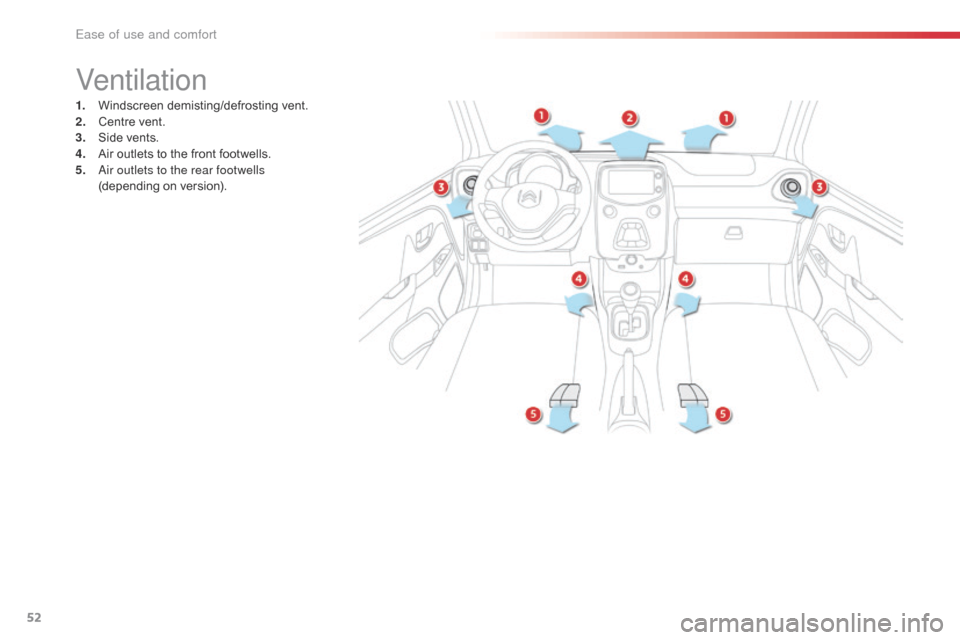
52
C1_en_Chap03_ergonomie-confort_ed01-2016
Ventilation
1. Windscreen demisting/defrosting v ent.
2. C entre vent.
3.
S
ide vents.
4.
A
ir outlets to the front footwells.
5.
A
ir outlets to the rear footwells
(depending
o
n
v
ersion).
Ease of use and comfort
Page 56 of 269
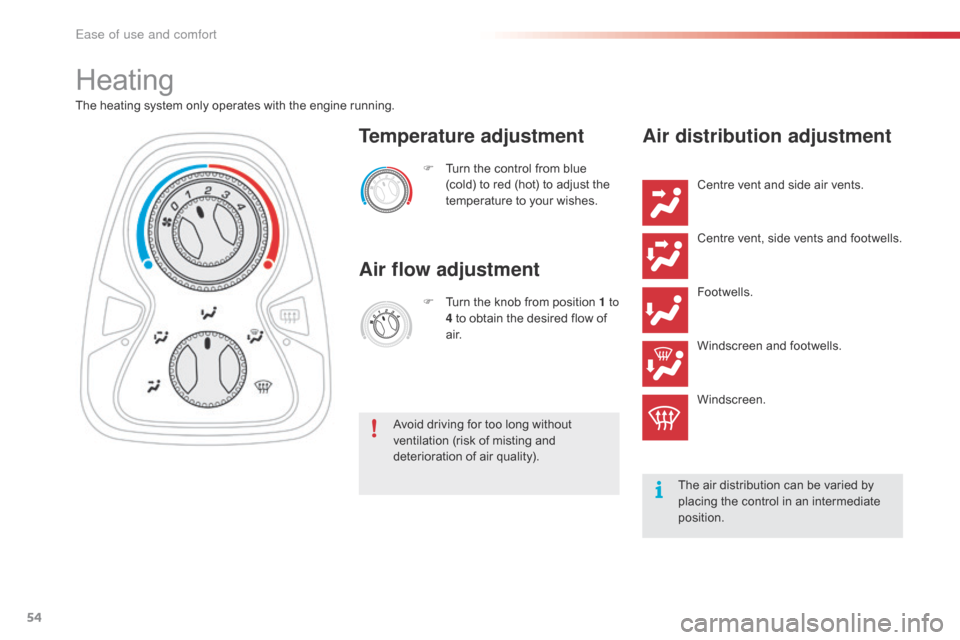
54
C1_en_Chap03_ergonomie-confort_ed01-2016
Heating
The heating system only operates with the engine running.F
T
urn the control from blue
(
cold) to red (hot) to adjust the
t
emperature to your wishes.
Temperature adjustment
Air flow adjustment
F Turn the knob from position 1 to
4 to obtain the desired flow of
a
i r.
Avoid
driving for too long without
v
entilation (risk of misting and
d
eterioration of air quality).
Air distribution adjustment
Centre vent and side air vents.
C entre vent, side vents and footwells.
Footwells.
Windscreen
and footwells.
Windscreen.
The
air distribution can be varied by
p
lacing the control in an intermediate
p
osition.
Ease of use and comfort
Page 57 of 269
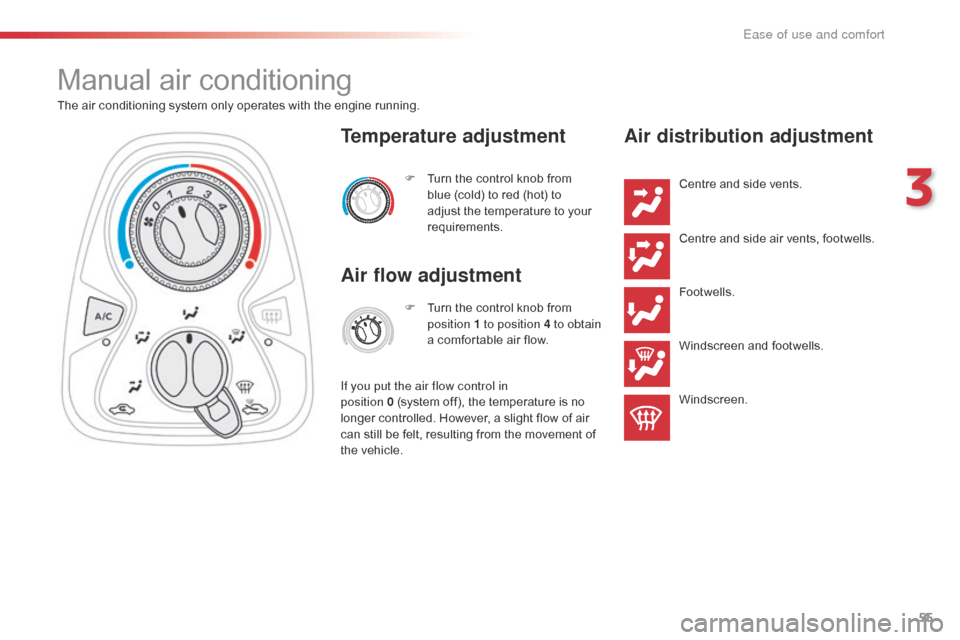
55
C1_en_Chap03_ergonomie-confort_ed01-2016
Manual air conditioning
The air conditioning system only operates with the engine running.
F
T
urn the control knob from
b
lue (cold) to red (hot) to
a
djust the temperature to your
r
equirements.
Temperature adjustment
Air flow adjustment
F Turn the control knob from p
osition 1 to position 4 to obtain
a
comfortable air flow.
If you put the air flow control in
position
0 (system off), the temperature is no
l
onger
controlled. However, a slight flow of air
c
an
still
be
felt, resulting from the movement of
t
he
vehicle.
Air distribution adjustment
Centre and side vents.
C entre and side air vents, footwells.
Footwells.
Windscreen
and footwells.
Windscreen.
3
Ease of use and comfort
Page 60 of 269
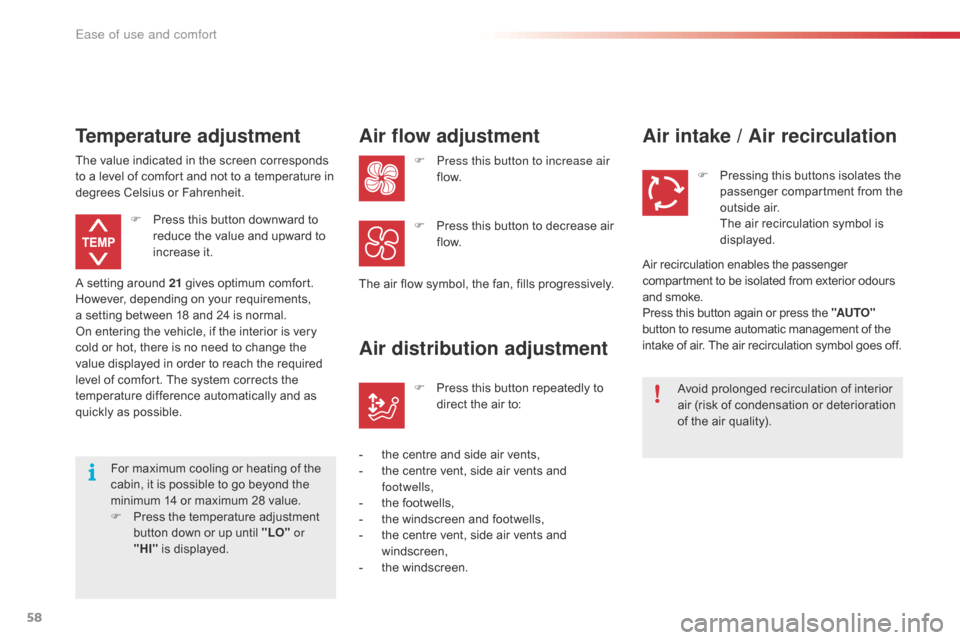
58
C1_en_Chap03_ergonomie-confort_ed01-2016
For maximum cooling or heating of the cabin, it is possible to go beyond the
m
inimum 14 or maximum 28 value.
F
P
ress the temperature adjustment
b
utton down or up until "LO" or
"HI"
is displayed.
A
setting around 21
gives optimum comfort.
H
owever, depending on your requirements,
a s
etting between 18 and 24 is normal.
On
entering the vehicle, if the interior is very
c
old
or hot, there is no need to change the
v
alue
displayed in order to reach the required
l
evel
of comfort. The system corrects the
t
emperature difference automatically and as
q
uickly as possible.
Temperature adjustment
F Press
this button downward to r
educe the value and upward to
inc
rease
it
.
The
value
indicated in the screen corresponds
t
o
a
level
of comfort and not to a temperature in
d
egrees
Celsius or Fahrenheit.
Air flow adjustment
F Press this button to increase air
f low.
The
air
flow symbol, the fan, fills progressively.
F
P
ress this button to decrease air
f
low.
Air distribution adjustment
- the centre and side air vents,
- t he centre vent, side air vents and
f
ootwells,
-
t
he footwells,
-
t
he windscreen and footwells,
-
t
he centre vent, side air vents and
w
indscreen,
-
t
he windscreen.F
P
ress this button repeatedly to
d
irect the air to:
Air intake / Air recirculation
Avoid prolonged recirculation of interior a
ir (risk of condensation or deterioration
o
f the air quality).
F
P
ressing this buttons isolates the
p
assenger compartment from the
o
utside air.
T
he air recirculation symbol is
d
isplayed.
Air
recirculation enables the passenger
c
ompartment to be isolated from exterior odours
a
nd
smoke.
Press
this button again or press the "AUTO"
button
to resume automatic management of the
i
ntake
of air. The air recirculation symbol goes off.
Ease of use and comfort
Page 62 of 269
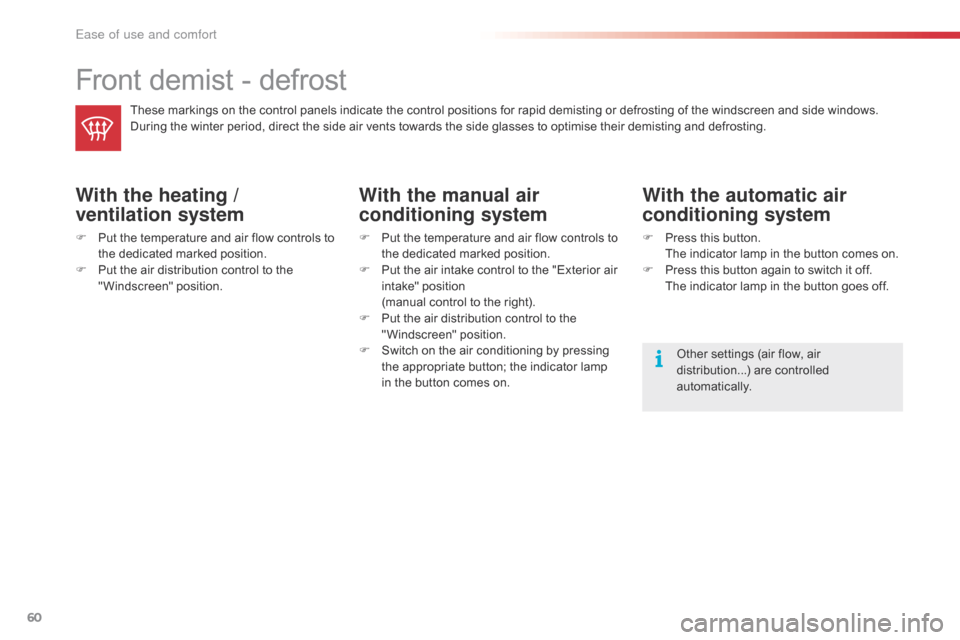
60
C1_en_Chap03_ergonomie-confort_ed01-2016
Front demist - defrost
These markings on the control panels indicate the control positions for rapid demisting or defrosting of the windscreen and side windows.
D uring the winter period, direct the side air vents towards the side glasses to optimise their demisting and defrosting.
With the heating /
ventilation system
F Put the temperature and air flow controls to t
he dedicated marked position.
F
P
ut the air distribution control to the
"
Windscreen"
p
osition.
With the manual air
conditioning system
F Put the temperature and air flow controls to t
he dedicated marked position.
F
P
ut the air intake control to the "Exterior air
i
ntake" position
(
manual control to the right).
F
P
ut the air distribution control to the
"
Windscreen"
p
osition.
F
S
witch on the air conditioning by pressing
t
he appropriate button; the indicator lamp
i
n the button comes on.
With the automatic air
conditioning system
F Press this button. T
he indicator lamp in the button comes on.
F
P
ress this button again to switch it off.
T
he indicator lamp in the button goes off.
Other
settings (air flow, air
d
istribution...) are controlled
au
tomatically.
Ease of use and comfort
Page 63 of 269
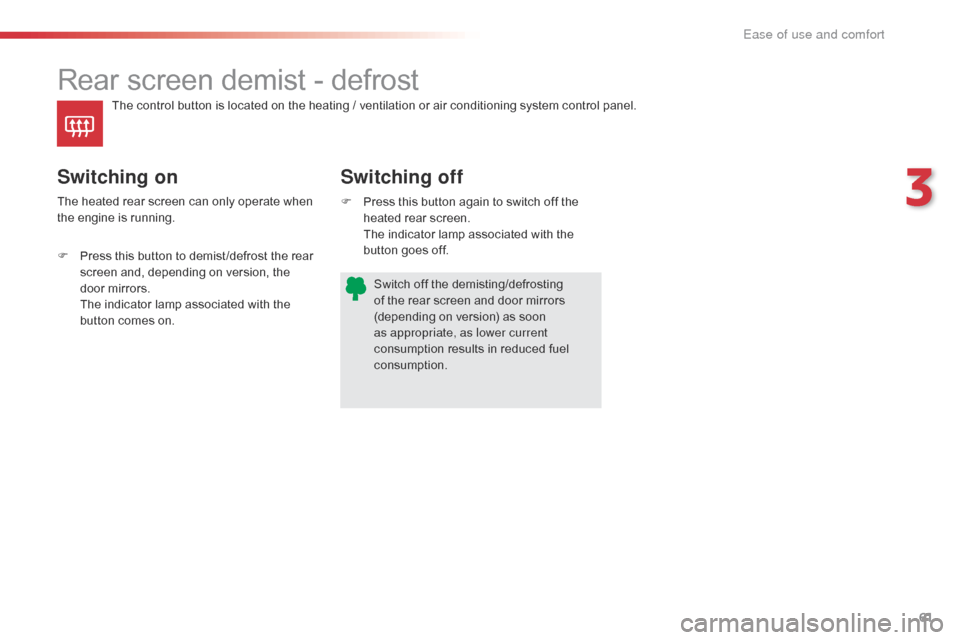
61
C1_en_Chap03_ergonomie-confort_ed01-2016
Rear screen demist - defrost
Switching off
Switching on
F Press this button again to switch off the h
eated rear screen.
T
he indicator lamp associated with the
b
utton goes off.
The
heated
rear
screen
can
only
operate
when
t
he
engine
is
running.
Switch
off the demisting/defrosting
o
f the rear screen and door mirrors
(
depending on version) as soon
a
s appropriate, as lower current
consumption
results in reduced fuel
c
onsumption.
F
P
ress
this
button
to
demist /defrost
the
rear
s
creen
and,
depending
on
version,
the
d
oor
mirrors.
T
he
indicator
lamp
associated
with
the
b
utton
comes
on.
The
control
button
is
located
on
the
heating / ventilation or air conditioning system control panel.
3
Ease of use and comfort
Page 65 of 269

63
C1_en_Chap03_ergonomie-confort_ed01-2016
Front fittings
1. Sun visor.
2. G love box.
3.
A
udio system, touch screen tablet or
s
torage.
4.
1
2 volt accessory socket
(maximum
120 W).
D
o not exceed the power rating to avoid
d
amaging your accessory.
5.
U
SB port.
6.
A
uxiliary socket.
7.
S
torage or cup holder.
8.
C
up holder.
9.
D
oor pockets.
S
torage for a bottle of water.
3
Ease of use and comfort
Page 67 of 269
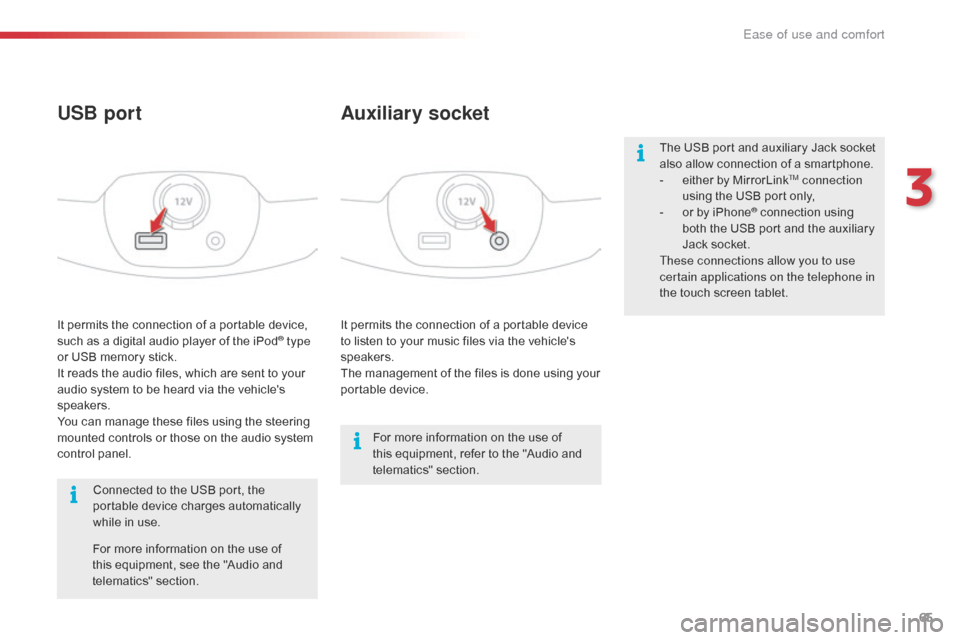
65
C1_en_Chap03_ergonomie-confort_ed01-2016
It permits the connection of a portable device to listen to your music files via the vehicle's
s
peakers.
The
management of the files is done using your
p
ortable
d
evice.
It
permits
the
connection
of
a
portable
device,
s
uch
as
a
digital
audio
player
of
the
iPod® type
or
USB
memory
stick.
It
reads
the
audio
files,
which
are
sent
to
your
a
udio
system
to
be
heard
via
the
vehicle's
s
peakers.
You
can
manage
these
files
using
the
steering
m
ounted
controls
or
those
on
the
audio
system
c
ontrol
panel.
Auxiliary socket
USB port
For more information on the use of t
his equipment, refer to the "Audio and
t
elematics"
se
ction.
For
more
information
on
the
use
of
t
his
equipment,
see
the
"Audio
and
t
elematics"
se
ction.
Connected
to
the
USB
port,
the
p
ortable
device
charges
automatically
w
hile
in
use. The
USB port and auxiliary Jack socket
a
lso allow connection of a smartphone.
-
e
ither by MirrorLink
TM connection
using
the
USB
port
only,
-
o
r
by
iPhone
® connection using b
oth
the
USB
port and the auxiliary
J
ack
socket.
These connections allow you to use
certain applications on the telephone in
the
touch
screen
tablet.
3
Ease of use and comfort
Page 88 of 269
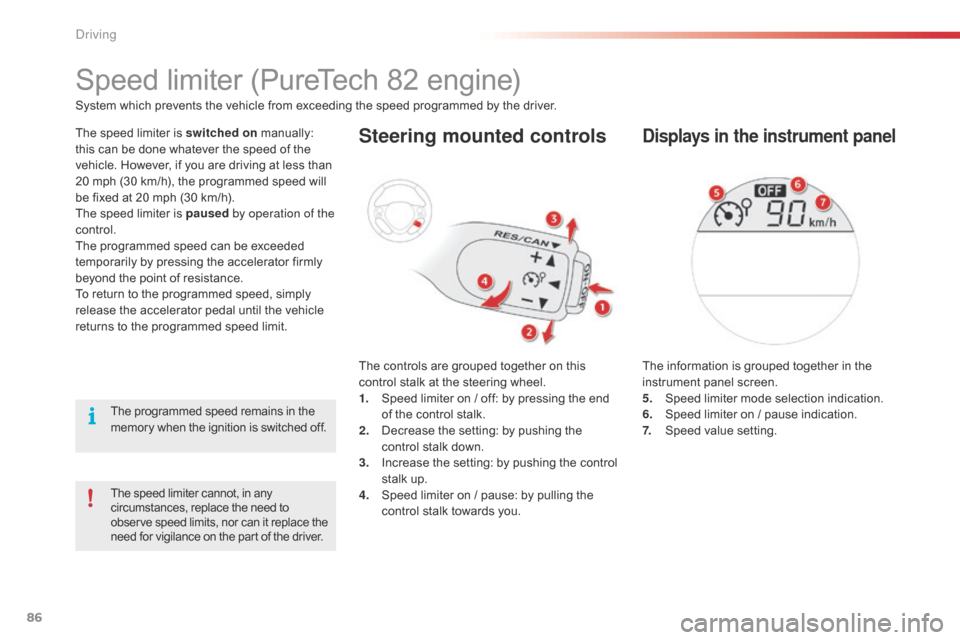
86
C1_en_Chap04_conduite_ed01-2016
The speed limiter cannot, in any circumstances, replace the need to o
bserve speed limits, nor can it replace the
n
eed for vigilance on the part of the driver.
Speed limiter (PureTech 82 engine)
The speed limiter is switched on manually: t
his can be done whatever the speed of the
v
ehicle. However, if you are driving at less than
2
0 mph (30 km/h), the programmed speed will
b
e fixed at 20 mph (30 km/h).
The
speed limiter is paused by operation of the
control.
The
programmed speed can be exceeded
t
emporarily by pressing the accelerator firmly
b
eyond the point of resistance.
To
return to the programmed speed, simply
r
elease the accelerator pedal until the vehicle
r
eturns to the programmed speed limit.
System
which prevents the vehicle from exceeding the speed programmed by the driver.Steering mounted controls
The controls are grouped together on this c
ontrol stalk at the steering wheel.
1.
S
peed limiter on / off: by pressing the end
o
f the control stalk.
2.
D
ecrease the setting: by pushing the
c
ontrol stalk down.
3.
I
ncrease the setting: by pushing the control
s
talk up.
4.
S
peed limiter on / pause: by pulling the
c
ontrol stalk towards you.
Displays in the instrument panel
The information is grouped together in the instrument panel screen.
5.
S
peed limiter mode selection indication.
6.
S
peed limiter on / pause indication.
7.
S
peed value setting.
The
programmed
speed
remains
in
the
m
emory
when
the
ignition
is
switched
off.
Driving